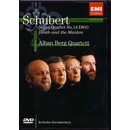The Artemis Quartet
The Artemis Quartet is one of the most promising young string quartets being heard today. I had already had occasion to work with them in 1996 during the making of the film "Death and the Maiden" along with the Alban Berg Quartet. The Artemis were there as "guinea pigs" to receive the sage advice of their famous elders on interpreting the Schubert piece. During the sessions on the shoot, they turned out to be an extraordinarily precious ingredient of the film's success -- in all respects. Their youth, their competence, their communicative ardour, the expressiveness of their faces - all these things that contribute so powerfully to the image and sound of a film made a very strong impression on me.
They were still students at the time. Since then, they have embarked on an active international career (a good hundred concerts a year) and it seemed to me that no other young quartet could better illustrate in a documentary the life of small group of musicians relentlessly devoted to perfecting the world's most beautiful musical works, with all the various problems this kind of existence implies.
With this problematic as a backdrop, our film will focus on a single musical work, one of the most ambitious and mysterious of the string quartet repertory, Beethoven's Die Grosse Fuge. One hundred and forty years after it was written, this work remains avant-garde, just like Beethoven's comment on the subject. The famous Schupanzig Quartet was labouring to decipher it, and the musicians complained of the insurmountable instrumental difficulties it presented. "What care I for your miserable instruments when the spirit moves me?" Beethoven is said to have cried.
I felt that an in-depth study of this masterful and frenzied musical score, punctuated by detailed sequences of meticulous rehearsals of the piece, would allow listeners to find their bearings and become familiar with the composition’s underlying structure prior to observing a complete reading of the work performed in public at the Théâtre de Bouffes de Nord in Paris, with which the film ends.
This documentary is presented together with a concert featuring Beethoven’s String Quartet Op.18 No.2, Verdi’s Quartet in E minor, and Webern’s Bagatelles for string quartet, Op.9, covering a representative selection of the Artemis Quartet’s diverse repertoire.
Two fundamental ideas guided me in the making of these films. The first was to explore in detail the complex intricacies of the score. Secondly, and perhaps more importantly, I strove to convey the very essence of what a string quartet is all about: interaction. For if there is one failing that members of a musical ménage à quatre must struggle to resist, it is egocentricity. A quartet functions on constant interactions, a dialogue of themes, motifs and sonorities that are expressed as images through an exchange of looks and gestures. There is nothing more expressive or captivating than this, which is precisely what I set out to capture with the aid of the camera. In other words, I embarked on a search for the secret of harmony in the life of a quartet, the secret that drives the Artemis Quartet.
Bruno Monsaingeon.
Translated from the by the author and S. Tooth Michelet
on the Artemis Quartet :
-
 Strings attached
Strings attached
French title: Scènes de quatuor
With the Artemis quartet, around Beethoven's "Grosse Fuge"
58' Date: 2001
EuroArts / Naxos -
 Death and the Maiden
Death and the Maiden
French title: La jeune fille et la mort
With the Alban Berg Quartet + the Artemis Quartet, Julia Varady and Dietrich Fischer-Dieskau
58' Date: 1996
EMI classics